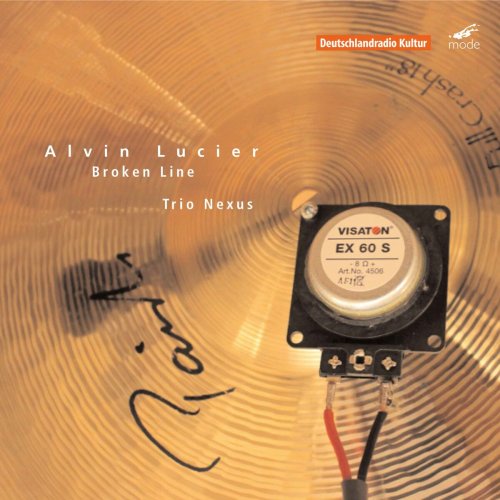
Trio Nexus - Alvin Lucier: Broken Line (2015)
BAND/ARTIST: Trio Nexus
- Title: Alvin Lucier: Broken Line
- Year Of Release: 2015
- Label: Mode [mode 281]
- Genre: Contemporary Classical, Modern
- Quality: FLAC (tracks)
- Total Time: 64:28
- Total Size: 243 mb
Alvin Lucier (b.1931) is the great American poet of acoustic phenomena. He has a keen sensitivity to the way objects vibrate, the way sound waves travel to our ears, and to the way our brain processes those vibrations. Trio Nexus is a Berlin based ensemble specializing in New Music.
Carbon Copies seeks the recreation on musical instruments of sounds recorded in the environment. Here, the musicians prepare the piece by making their own 15-minute recordings “of any indoor or outdoor environment.” These are then played back simultaneously. The musicians then mimick the environment which they hear on their instruments; then the recording is faded out and they continue to play via looping, or by anticipating, delaying, truncating or elongating the sounds at will.
Risonanza takes the central idea to find an object that can be excited by sound such that it responds with a sound of its own, as though becoming, in the composer’s words, a “non-breathing player,” a fourth member of the ensemble.
Music for Pure Waves, Bass Drums and Acoustic Pendulum has the concept that electronic sounds – what Lucier calls a “slow sweep oscillator” which makes a slow, continuous glissando movement – excite the skins of four large bass drums, causing them to vibrate and to set in motion extremely light pendulums suspended in front of them. As the bass drums begin to vibrate under excitation from the oscillator, the pendulums begin to swing, as if by magic, more or less actively, gently striking the drumhead in a regular rhythm.
Broken Line, written for Trio Nexus, is about as close as Lucier has ever come to writing chamber music in the traditional sense. The piece consists of a series of flute glissandi spanning the intervals of a semitone, major second and minor third respectively. Vibraphone and piano play long tones during the glissandi, creating either unisons, octaves, or fifths and twelfths against the flute lines. Because the flute tone is continuously in motion this has the effect of creating beats – audible “wah wah” patterns in the sound. These gentle rhythmic fluctuations – which appear of their own accord without the performers needing to do anything – are like the flickering of a candle in the wind.
Carbon Copies seeks the recreation on musical instruments of sounds recorded in the environment. Here, the musicians prepare the piece by making their own 15-minute recordings “of any indoor or outdoor environment.” These are then played back simultaneously. The musicians then mimick the environment which they hear on their instruments; then the recording is faded out and they continue to play via looping, or by anticipating, delaying, truncating or elongating the sounds at will.
Risonanza takes the central idea to find an object that can be excited by sound such that it responds with a sound of its own, as though becoming, in the composer’s words, a “non-breathing player,” a fourth member of the ensemble.
Music for Pure Waves, Bass Drums and Acoustic Pendulum has the concept that electronic sounds – what Lucier calls a “slow sweep oscillator” which makes a slow, continuous glissando movement – excite the skins of four large bass drums, causing them to vibrate and to set in motion extremely light pendulums suspended in front of them. As the bass drums begin to vibrate under excitation from the oscillator, the pendulums begin to swing, as if by magic, more or less actively, gently striking the drumhead in a regular rhythm.
Broken Line, written for Trio Nexus, is about as close as Lucier has ever come to writing chamber music in the traditional sense. The piece consists of a series of flute glissandi spanning the intervals of a semitone, major second and minor third respectively. Vibraphone and piano play long tones during the glissandi, creating either unisons, octaves, or fifths and twelfths against the flute lines. Because the flute tone is continuously in motion this has the effect of creating beats – audible “wah wah” patterns in the sound. These gentle rhythmic fluctuations – which appear of their own accord without the performers needing to do anything – are like the flickering of a candle in the wind.
TRACKLIST:
1 Carbon Copies (1989) 20:06
2 Risonanza (1982) 13:12
3 Music for Pure Waves, Bass Drums and Acoustic Pendulums (1980) 18:52
4 Broken Line (2006) 11:55
Sebastian Berweck – Piano
Martin Lorenz – Percussion
Erik Drescher – Flute
As a ISRA.CLOUD's PREMIUM member you will have the following benefits:
- Unlimited high speed downloads
- Download directly without waiting time
- Unlimited parallel downloads
- Support for download accelerators
- No advertising
- Resume broken downloads


